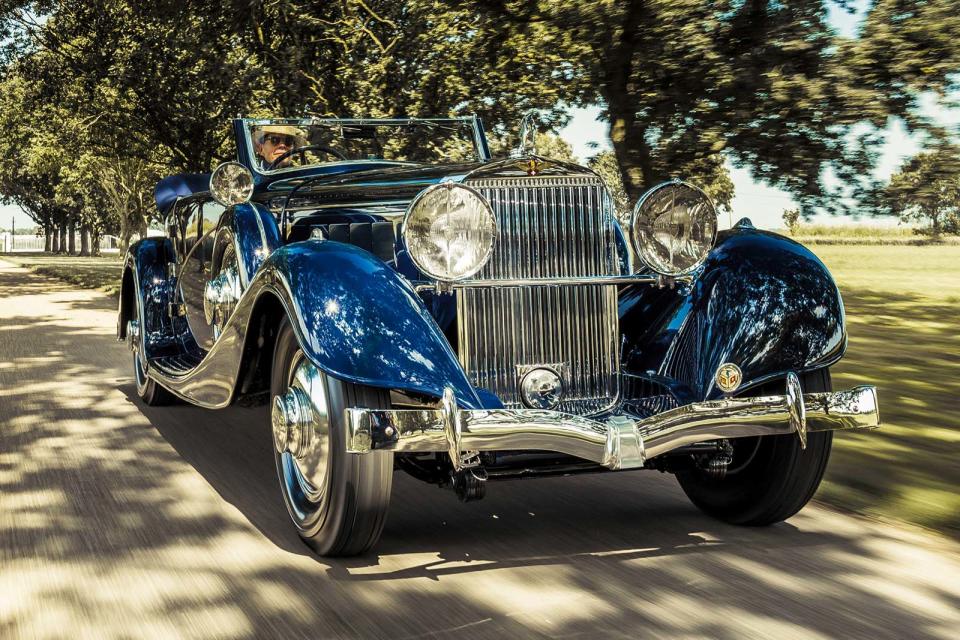From the archive: driving the world's most magnificent car

Like our test car, this 1935 J12 is a Vanvooren cabrio
“The mere mention of the name Hispano-Suiza suggests a car of the highest quality. Thus, when it is announced that this firm has decided to market a 12-cylinder model, one naturally expects to find something of more than ordinary interest.
"In this respect, one is not disappointed, for that designed by Marc Birkigt is a car of exceptional merit,” we reported ahead of 1931’s Paris motor show.
The engine the Swiss genius had created for the Spanish company’s new J12 flagship was a 60deg V12 of a square 9424cc that used some aeronautical techniques (he had designed a V8 that powered French and British fighter biplanes in World War I) and was “remarkable for its cleanliness of design and the accessibility of the auxiliaries”.
Three years later, we could barely contain our excitement as the British importer gave us a cabriolet bodied by Vanvooren of Paris – where the chassis had also been produced, Hispano-Suiza having opened a factory there back in 1911 – for a road test.
Enjoy full access to the complete Autocar archive at themagazineshop.com
“It is a car of which a true perspective cannot possibly be rendered in a few words,” we said. “Figures alone can tell the greater part of the story. The set obtained on this car are of an amazing order, surpassing, as a whole, any similar set of test data recorded by The Autocar for an ordinary production machine.”
This was no shock when it had that vast engine making more than 200bhp – beaten only by Bugatti’s Royale straight eight, which wasn’t really relevant, being so expensive that just seven were ever made.
That sounds weak today when even a Volkswagen Polo GTI makes 200bhp, but consider that Austin’s 1934 Ten family saloon had 20bhp.
“But the point of this car is not just that it is capable of a genuine 100mph – the best of several runs taken at Brooklands, on the level and against a quite strong wind. It is that there is no effort whatsoever.
“It runs on a very high top gear ratio, and probably the engine does not have to develop anything like the full amount of power that would actually be possible with its size, so that the car does 90 or 100 in literally as easy a fashion as a car of lesser size will do 60 or 70.
“Yet the significance of even these figures is not easily grasped. The car has to be tried to be believed, and the tremendous ease of the performance, as well as its vivid nature, appreciated.”
Our J12 had the shortest of the four chassis, but even this made it one of the largest cars around – and yet “certainly it does not feel unwieldy, for the steering is light and desirably accurate, the front wheels being felt to some extent through the steering wheel but not excessively, whilst the gear change, with a synchromesh for second and top, can be handled very rapidly, with a single [press] of the clutch pedal, or quite lazily.
“Braking is superlatively good; very light pedal pressure gives just the amount of deceleration required, this being attributable to the famous Hispano-Suiza friction-type mechanical servo.
“In a short trial of such a car, coachwork is apt to receive less attention than it actually merits.
“Here unquestionably is one of the world’s finest cars in both design and performance.”
The elites who could afford a £3500 car during the Great Depression (that’s £207,360 to us, while the Ten was £172, or £10,190) agreed. They included King Carol of Romania, three Indian maharajas, Dior bankroller Marcel Boussac, racing count Carlo Felice Trossi, artist Pablo Picasso, banker Anthony de Rothschild, Spanish dictator Francisco Franco (receiving the armoured limo just in time for his 1939 victory parade) and the future shah of Iran (a 12th-birthday present from his father!).
That’s not to mention balloonist Émile Dubonnet, whose brother André – a flier, racer and inventor – in 1938 commissioned Saoutchik to make a stunning art deco body for the straight-six Hispano-Suiza Junior, called Xenia.
And 81 years later, that would inspire the debut car from the reborn Hispano-Suiza brand (car making had ended just before World War II as the now French firm refocused on aero V12s and cannons), the 1005bhp electric Carmen. Sadly, it didn’t live up to the brand’s image, getting only a lukewarm review from us.
]]>

 Yahoo Autos
Yahoo Autos 